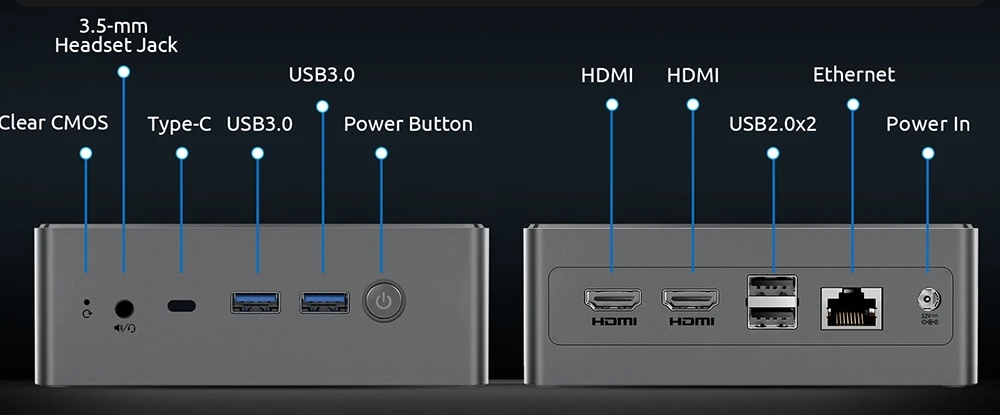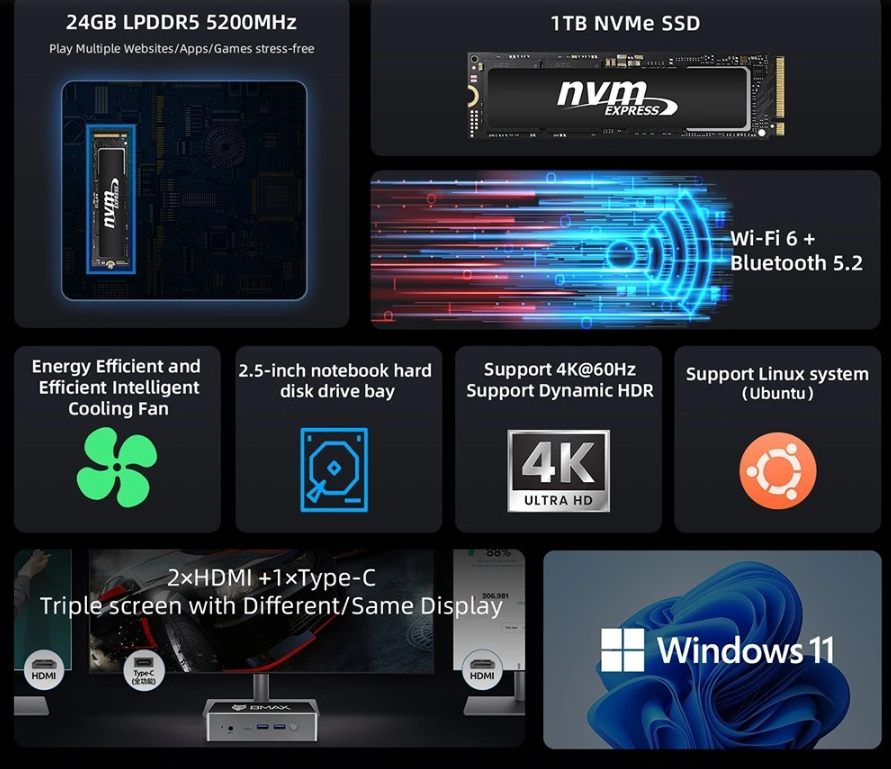The field of computing is undergoing a major transformation, with minicomputers becoming increasingly prominent. These small-form factor PCs are challenging the long-standing dominance of traditional desktop computers and ushering in a new era of compact computing. As technology advances, the growing number of people opting for mini PCs reflects the growing demand for streamlined and space-saving devices that offer powerful performance in smaller packages. So what is the difference between traditional desktop computers and mini PCs, and what are the advantages of each?
Performance
Although mini PCs are compact, modern technology allows some high-end mini PCs to be quite powerful and well-suited for daily work, study, creation, and entertainment needs. Mini PCs are also suitable for gaming and professional applications if equipped with high-performance processors such as AMD Ryzen 7. However, the shortcoming of mini PCs is the graphics card, because independent graphics cards generate a lot of heat when running, while mini PCs are more compact in design, and most use integrated solutions, which naturally sacrifices part of the graphics card performance for controlling heat. Traditional computers tend to have advantages in hardware expansion and performance, supporting higher-spec components such as high-end graphics cards, multiple hard drives, and memory slots. Therefore, under extreme performance requirements, especially demanding image display processing and large-scale game operations, traditional computers may have more advantages.
Scalability and Upgradeability
Traditional computers usually have abundant expansion interfaces and slots, and users can easily upgrade hardware, such as adding memory, replacing graphics cards, or adding more storage devices. Due to size limitations, mini PCs are relatively less expandable and upgradeable, and some components may not be replaced or upgraded.
Portability and Space-Saving Design
One of the main advantages of mini PCs over traditional desktops is their portability. Mini PCs are small in size, compact in design, light in weight, can be placed upright, horizontally, or mounted on the back of the monitor, and are easy to move and install. They are very suitable for users with limited space or who need to work on the move without affecting performance or functionality. Traditional desktop computers are larger, bulkier, not easy to carry, and take up a lot of space. Whether transitioning between home and office environments or accommodating frequent travel, the mini PC’s portability adds convenience that may be unmatched by traditional desktops and is an attractive option for individuals looking for a tidy and efficient computing solution.

Heat Dissipation and Noise
Many mini PCs adopt fanless or low-noise designs and run almost silently (some mini PCs are also equipped with cooling fans), reducing problems caused by fan failure and reducing some later maintenance and repair costs. Traditional computers are usually equipped with fans for heat dissipation, which may produce loud noises during operation, and fan failures are common.
Power Consumption and Energy Saving
Mini PCs have a compact size and optimized design, so they have lower power consumption and are more energy-saving. Most mini PCs use low-power chips, and the power consumption of the entire machine is around 10W-25W. The power consumption of traditional computers is relatively high, especially when running at high performance, the energy consumption is large, and the power consumption of the whole machine is about 150W-300W.
Price
For the unique design and integration, the price of high-end mini PCs may be comparable to or even higher than traditional computers with the same performance. While due to market competition and standardization of components, traditional computers have a wider price range, and users can choose different configurations according to their budget and their own needs.
In general, mini PCs are more suitable for users who have requirements for space and portability and do not have particularly high performance requirements, while traditional computers are more suitable for users who require powerful performance, scalability and upgradeability. However, with the development of technology, the performance of mini PCs is gradually improving and may compete with traditional computers in more application scenarios in the future.
- Intel Core i7-1255U, 10 Cores 12 Threads 4.7GHz
- Intel Iris Xe Graphics
- Support Linux system
- 24GB DDR5 RAM, 1TB NVMe SSD
- WiFi 6 Bluetooth 5.2
- 2*HDMI+1*Type-C 4K@60Hz Triple Display
- 2*USB3.0, 2*USB2.0, 1*RJ45
- Cooling Fan
- AMD Ryzen 7 5700U, 8 Cores 4.3GHz
- AMD Radeon Graphics
- 16GB DDR4 RAM, 512GB M.2 SSD
- WiFi 5 Bluetooth 4.2
- HDMI+DP+Type-C 4K 60Hz Triple Display
- 4*USB 3.0, 1*1000Mbps LAN
- 3 Modes















